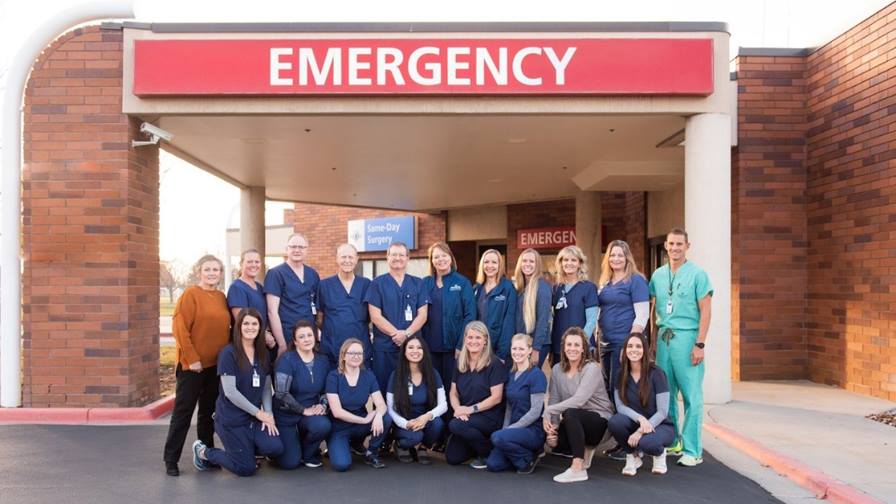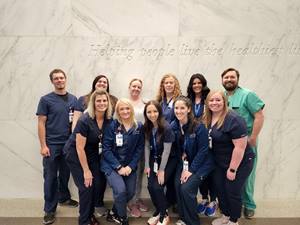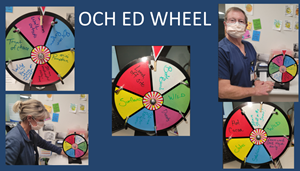

[The Spanish Fork Hospital Emergency Department
This is part two of a four-part series focusing on the success of Intermountain’s emergency departments (ED). This week, three ED hospital leaders share common themes and tactics used to improve the patient experience.
Leaders build trust with their teams by working alongside them and keeping everyone focused on “true north.” Evidence from our internal data shows having strong, engaged teams leads to strong patient trust and better outcomes. Engaged teams also have fun. This week we’re learning from the success of Intermountain’s ED teams and three managers who’ve excelled in both caregiver and patient experience by working shoulder-to-shoulder with their teams and making sure fun is a part of their work.
Walking the talk
To integrate himself into the daily work of his team, Jared Stevens, St. George Regional Hospital’s ED nurse manager, can be found emptying trash and transporting patients. When reflecting on the concept of servant leadership, Jared says, “One of the most important things for a leader to do is create open communication and connection with their team, working shoulder to shoulder with them on the unit.”
Julie Winegar, Orem Community Hospital’s ED nurse manager, regularly takes over patient care for her nurses so they can have a moment to themselves to get outside, go for a walk, or have a break. Her team is one of Intermountain’s top performing, most engaged ED teams for both caregiver and patient experience. They’ve been at the 85th Percentile Rank or higher since 2018, and are currently at the 91st Percentile Rank, year-to-date for Likelihood to Recommend.
Julie’s team respects her for walking the talk. “It’s my honor to care for the team since they’re the ones doing the heavy lifting … I try to ‘free the clutter’ and show them they have a leader who cares about them. Our team motto is we’re in this together WITH patients,” Julie says.
Stay focused on “true north”
To maintain momentum, these teams reflect on their core goals each day, and the steps it will take to achieve them. “We’ve talked about our why several times throughout the year,” says Cassie Purkey, Spanish Fork Hospital’s ED nurse manager. “If you focus on providing excellent care with each patient interaction, then other important things like safety and caregiver engagement all fall into place. To support each other, we often say, ‘No one sits until we all sit.’”
take great care of our patients.

The Orem's Emergency Department's Carnival Wheel
Don’t forget to have fun
The three ED managers try to insert fun and play into their work wherever possible. Orem Community Hospital’s ED has a carnival wheel. Caregivers spin the wheel for a chance to win a simple prize, like listening to a Brian Regan comedy routine for a few minutes so they can laugh together as a team. Other prizes include:
- Flowers
- Donuts
- Bath bombs
- 30 minutes of recliner time (while someone covers their patients)
- Breakfast
- Lunch offsite
- Hot cocoa on a cold day
The team often uses the wheel to break up the day during a rough shift, or when their team is going through a hard time. It’s a welcome reprieve that lifts spirits and translates into closer teams.
ED leaders across Intermountain are very intentional about creating an atmosphere of recognition, gratitude, and positivity. They distribute care packages, send handwritten cards, and create meaningful opportunities for teams to pull together during difficult times to recognize each other and express thanks.
“Focusing on our wins drives us forward,” says Jenna Heath, RN, Spanish Fork Hospital ED. “We want to learn and improve, highlighting the positive keeps us going.”
Watch your inbox for next week’s Lead Informed ED feature with more tactics to improve engagement and performance.
Does your team need help improving performance and making it stick?
Encourage use of your team’s Likelihood to Recommend Guide to identify what’s working well, where your team can improve, and the steps you can take to get there. For example, is the ED service line doing something that would improve care for your caregivers and patients? Share this article with your team and discuss what might work for you.
If you’re a leader of leaders, ask these questions while rounding and during Check-ins to support and align experience improvement efforts.

